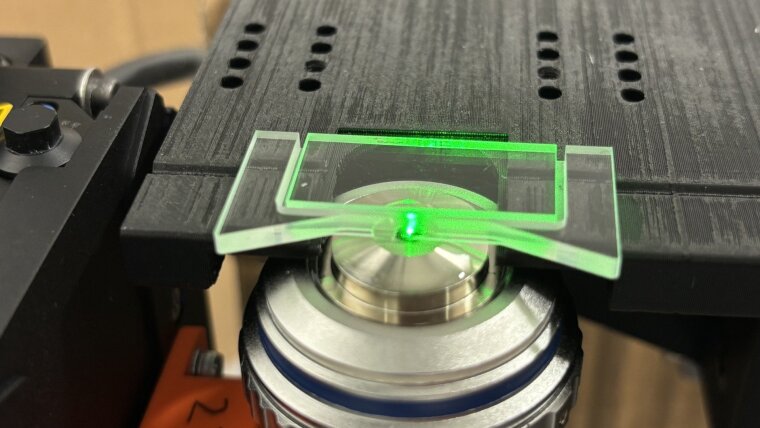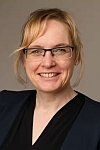
Prof. Dr. Maria Dienerowitz
Image: Grit HiersemannMaria Dienerowitz is Professor of Laser Technology at the Ernst-Abbe-Hochschule Jena (EAH), specializing in optical manipulation and instrumentation. At the Deutsches Optisches Museum, she leads the team for the development of interactive exhibits and the integration of physical concepts into the exhibition.
She studied physics at the University of Karlsruhe (TH) and the University of Central Florida, completing her degree with distinction in 2005. Her doctoral research at the University of St Andrews focused on optical tweezers and plasmonic nanoparticles. Subsequently, she conducted postdoctoral research at the University of Glasgow, working on piconewton force measurements and holographic beam shaping. Before joining EAH Jena in October 2022, she expanded her research in single-molecule microscopy at the University Hospital in Jena.
Research Areas
The group’s research encompasses optical and single-molecule trapping as well as the development of compact optical instruments that enable the direct investigation of bacteria and single molecules in biological laboratories. In parallel, the group designs laser metrology systems for cultural heritage applications, such as the contact-free characterisation of historical spectacle lenses for the Deutsches Optisches Museum.
Main research topics include:
- Optical manipulation of nanoparticles and biomolecules using optical tweezers and holographic beam shaping.
- Single-molecule trapping and fluorescence techniques such as Förster Resonance Energy Transfer (FRET) to study molecular dynamics.
- Development of integrated optical systems for biomedical diagnostics, including microfluidics lab-on-a-chip devices.
- Development of didactic laboratory experiments in optics and concepts for interactive science communication in museum exhibitions.
Prof. Dienerowitz is currently leading several research projects that integrate optics and biomedicine: Financed by the Carl-Zeiss Stiftung, BioLOC aims to develop a lab-on-a-chip system for the optical characterization of molecular dynamics. This system combines microfluidics with light-sheet microscopy to analyze freely moving single molecules, enhancing sensitivity and minimizing interference. Additionally, she co-leads the TOOLS initiative, a DFG-funded interdisciplinary project that develops tailored optical systems for biomedical applications such as detecting bio-nanoparticles and improving endoscopic diagnostics.
Teaching Fields
Prof. Dienerowitz teaches undergraduate and postgraduate courses in optics, laser technology and photonics. These currently include:
Undergraduate
- Introduction to Laser Technology
- Applied Optics and Laser Applications
Postgraduate
- Laser Technology
- Laser Metrology
- Nonlinear Optics
- Laser-based Imaging in Microscopy
Beyond academic teaching, she is committed to science communication and education. She regularly presents research to the general public and develops hands-on workshops in optics for children from primary school age onwards.
Research Methods
- Optical tweezers for trapping and manipulation of nanoparticles and bacteria.
- Single-molecule fluorescence techniques, including FRET, to study conformational changes and interaction dynamics.
- Microfluidic systems combined with optical methods for controlled experiments on bacteria and single molecules.
- Lightsheet microscopy and fluorescent bleaching kinetics
- Exploring different didactic approaches, such as the Paderborner Physikpraktikum 3P, to design engaging laboratory experiments in optics and laser technology.
Recent Research Results
The group is currently establishing a compact optical tweezers system to measure interbacterial forces. It has developed a portable optical tweezers setup for science communication and education. In parallel, the group is setting up single-molecule experiments in microfluidic environments. It also conducts optical metrology on historical spectacle lenses in collaboration with the Deutsches Optisches Museum and realises complex exhibition experiments, including a Foucault-type rotating mirror system to measure the speed of light.
[1] T. Mappes, M. Dienerowitz, Phys. J. 23, 25–30 (2024).
[2] H. Sielaff, F. Dienerowitz, M. Dienerowitz, Nanoscale 14, 2327 (2022).
[3] M. Dienerowitz, et al., Methods 193, 96 (2021).
[4] C. Riesenberg, et al., Front. Bioeng. Biotechnol. 8, 598459 (2020).
[5] M. Dienerowitz, et al., Curr. Microbiol. 69, 669 (2014).
[6] G. Gibson, et al., Rev. Sci. Instrum. 83, 113107 (2012).
